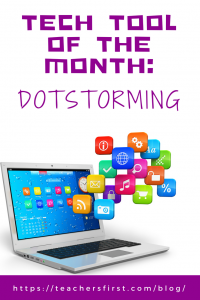 It has been almost 100 years since the 19th Amendment was signed, giving women the right to vote. Women’s Equality Day is celebrated on August 26th. This day celebrates this “winning vote” of 98 years ago. In honor of this day, we are highlighting a tech tool that you can use for voting in your classroom. Cast your vote using Dotstorming.
It has been almost 100 years since the 19th Amendment was signed, giving women the right to vote. Women’s Equality Day is celebrated on August 26th. This day celebrates this “winning vote” of 98 years ago. In honor of this day, we are highlighting a tech tool that you can use for voting in your classroom. Cast your vote using Dotstorming.
Dotstorming is a voting tool like no other. This fabulous find allows you to create online bulletin boards for brainstorming. Once you have created the bulletin board, your students can vote! Getting started is simple. Create an account and begin (no need to wait for email confirmation). Now you can create your board, add a title, and choose how many votes your students can have (10 is the max per user). Add text, videos, and images to your board. You can add images and videos using a URL or upload them from your computer. When students join, they provide their name and can immediately add posts. Finalize your board when finished; voting can continue after the “brainstorm” is over. A free account allows you to have one fully featured board. If you wish to create another board, delete your existing board and start out fresh.
How could you use this tool in your class? If you need to make any decisions as a class, this is the perfect tool to give every student a voice. Use this tool to debate hot topics in class from current events or historical decisions. Choose project options, class books to read together, and more with the voting poll. Students could use the boards to create projects to share research on a science or social studies topic. Boards could also be used as an alternative to a book report. Students could brainstorm ideas to share their thought process while choosing a final project. Dotstorming is perfect to share ideas in science, writing, current events, and truly any subject.
And finally, let’s talk about some helpful tips for using Dotstorming in your class. Consider having students use a code or their initials to participate, rather than a full name. You will be able to see the code in the chat box, as well as the message the student posted. However, you cannot see who voted for what; ask students to post a comment with their vote and type their code or initials with the comment. Allowing students to make comments and post on the wall offers you an excellent opportunity to discuss digital citizenship and establish specific “digital” class rules.

